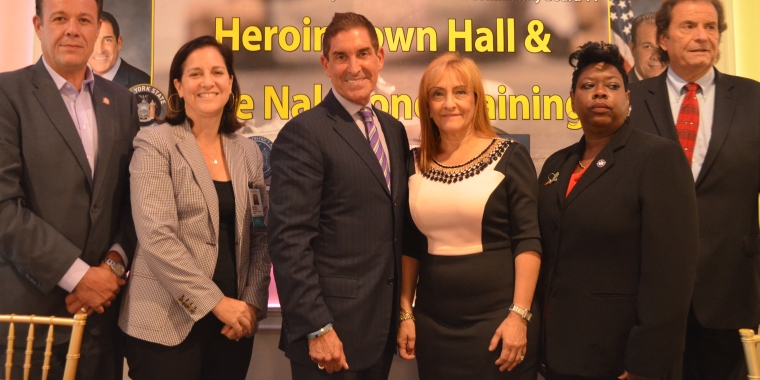
IDC Releases Regulation Reform Plan
Jeffrey D. Klein
February 7, 2012
Some New & Outdated Agency Rules Threaten Key Industries, Tax Resources, Provide Little Public Protection, IDC Finds
The Independent Democratic Conference today unveiled a plan to reform New York's regulatory process, putting safeguards in place that will protect businesses from overly burdensome regulations, protecting residents, and creating a more stable economic environment.
The reform plan came after an exhaustive review by the IDC that found a series outdated rules and proposed regulations that stifles economic growth, and, in some cases, could destroy key industries in New York without a corresponding public benefit.
“We need to end this era where red tape and over-regulation are used to strangle New York's economic vitality,” said Senator Jeffrey D. Klein, (D-Bronx/ Westchester). “We're proposing commonsense fixes that will bring balance to our regulatory system, and ensure that New Yorker's are protected while businesses that are the lifeblood of our economy are not regulated right out of this state.”
Under the leadership of Senator David Carlucci, (D-Rockland/ Orange), the Co-Chair of the Administrative Regulations Review Commission, the IDC reviewed all regulations proposed and developed during the last three years. They found 794 new rules and regulations were proposed by state entities – 745 of which were adopted.
"This report clearly demonstrates the need for New York to reform its regulatory system so that businesses and our overall economic competitiveness will be able to thrive without sacrificing the need for oversight,” said Senator Carlucci. “As Chairman of ARRC, I have always believed that we need to bring government up to speed with the 21st century so that unneeded fines, taxes and fees will not be the solution to every challenge we face. Once again, my colleagues and I have brought real ideas into the public eye and I look forward to discussing these in the weeks and months ahead."
Also found were instances where state regulators proposed rules that did not factor in costs and ramifications to key parts of New York's economy, or where outdated regulations continued to be enforced.
Key among these were:
Regulation | Industry Impacted | Industry Contribution to NY or Regional Economy | Negative Impact |
Certificate of Need (CON) Process | Healthcare Industry | $73.5 Billion to NYS GDP, $58.6 Billion in payrolls in 2009 | Slows ability to maintain existing facilities, construct new facilities. Each year of delay can increase costs by 12%. With $2 Billion in delayed projects, this adds up to $240 million |
- An outdated regulation by the Department of Health that requires a Certificate of Need for construction projects at healthcare facilities. While this was initially a federal mandate designed to contain costs, the federal government dropped this requirement in 1987 amid evidence showing the requirement wasn't working. New York continues the COD regulation. The Greater New York Hospital Association noted that healthcare-related construction costs in New York increased 12 percent each year, while applications made their way through the “all-too-slow” approval process. According to the Hospital Association of New York State, some $2 billion in construction projects are being held up.
“Hospitals are facing serious challenges because of decreased funding, and it is incumbent upon us to help them be as efficient as possible by removing unnecessary and costly obstacles,” Senator David J. Valesky said. ”Construction that is necessary to maintain high quality patient care should not take years to approve.”
Kenneth E. Raske, President of the Greater New York Hospital Association, said: "I applaud the IDC for their commitment to streamlining the burdensome web of regulations that hospitals with scarce resources must navigate, especially the Certificate of Need (CON) program" said "The CON program no longer effectively serves its intended purpose of promoting cost control, quality, and access. We look forward to working with the IDC to improve not only the CON process, but New York's entire health care delivery system."
Regulation | Industry Impacted | Industry Contribution to NY or Regional Economy | Negative Impact |
Child Actor Work limits | Film and Theater Industries | In 2008 Film Industry contributed $5 Billion in total wages, Theater Industry $1 Billion in Economic Activity in 2008-09 | Limits the hours child actors can work, threatens profitability of productions that prominently feature children. Just one such Show, Mary Poppins, did $45 million in sales in 2010 |
- Proposed regulations by the state Department of Labor restrict the hours that child performers can work, bar any work after 10 p.m. and actually limit parental supervision. These restrictions would have harmed New York's film and theater industries, which combined contribute at least $6 billion to New York's economy. Regulators have amended their proposed regulation changes following outcry from performers, their parents, industry representatives Senator Carlucci, and others. This situation, however, highlights the need to reform the regulatory process by getting input from the affected businesses and industries at the beginning stages.
Kelly Crisp, Founder, Child Performers Coalition, said: "The NYS Department of Labor's handling of the Child Performer regulations highlights the demand for greater oversight of state agencies and the need for a more open, participative regulatory process. Under the current system, agencies have the ability to impose sweeping, game changing regulations that, in the case of the Child Performer regulations could have resulted in extremely dangerous working conditions for children and loss of entertainment industry production jobs and revenue for the State of New York."
Regulation | Industry Impacted | Industry Contribution to NY or Regional Economy | Negative Impact |
Ballast Water Standards | Shipping and Transportation Industries | $49 Billion in Business and Personal Income, 280,000 Jobs total in 2010 | Limits the number of ships able to travel in NYS waters. Current technology unable to meet proposed standards. Entire $49 billion in economic activity threatened. |
- New rules governing cargo ships, set to take effect in 2013 and aimed at curbing the spread of invasive species in New York waterways, are 100 times more restrictive than federal standards. Currently, the technology to comply with these standards does not exist. Companies in this trade worry that these more stringent requirements would result in ships simply avoiding New York's waters in favor of doing business with surrounding states.
“Water doesn't stop when it hits New York borders, but thousands of cargo ships will if these new ballast water standards go into effect,” Senator Diane Savino, (D-Staten Island/ Brooklyn), said. “This will be a severe and direct impact to a $49 billion dollar industry that supports more than a quarter million local jobs. This is a textbook example of why we need a common sense approach to regulations in New York.”
Regulation | Industry Impacted | Industry Contribution to NY or Regional Economy | Negative Impact |
NY Registry of Pesticides | Agricultural and Landscaping Industries | NYS Farms had $4.4 Billion in Sales in 2007 | Slows down the ability of businesses to use pesticides already approved by federal government. Each decision can take up to more than 5 months and is accompanied by a $620 fee. |
- New York has different pesticide standards than the federal government, and a separate approval process. This puts New York farmers at a disadvantage as they wait for state approval of pesticides that were already certified by the federal Food and Drug Administration. New York farmers are competing for New York consumers with food grown all over the country and all over the world. This additional burden makes New York grown products more expensive and leads to consumers choosing to purchase produce grown elsewhere.
Jeff Williams, Manager of Government Relations for New York Farm Bureau, said: "Costly and unnecessary regulations are one of our members' top concerns. This is especially true when the regulations impact our access to newer, safer crop protectants, or make it harder to heat our houses and barns in rural New York when oil costs have risen to $4 a gallon. We look forward to working with the Independent Democratic Conference to remove regulatory roadblocks and allow our farmers to reinvest in their business so they can continue to grow and prosper.”
Regulation | Industry Impacted | Industry Contribution to NY or Regional Economy | Negative Impact |
Yearly Renewal of Sales Tax Certificate of Authority | Wholesale, Retail. and Service Industries | $280 Billion in sales from taxable services in FY 2008-09 | Each business that collects sales tax must spend time each year recertifying for their certificate, even if no information has changed. Each hour on average can cost $25 to a business |
- Small businesses each year are required renew their certificates of authority to legally collect sales tax for the state Department of Taxation and Finance. Many businesses complain that it takes hours, or in some cases, days of lost productivity to simply re-file the same information with the state. This requirement not only imposes costs in time to small businesses, but also taxes Taxation and Finance resources.
The IDC's Regulation Reform Plan calls for:
Opening Up the Regulation Process
- Shorten the review of any substantial regulation impacting Small Businesses, Local Governments, or Rural Entities from five years to two years. The current five year review period is just too long for many businesses in New York. By the time the review comes, many of the affected businesses could very well be closed, or have moved to another state with a more hospitable business and regulatory climate.
- Agencies would be mandated to seek input from industries and groups affected by a new regulation, or rule change prior to the rule being drafted and filed on the state register. These comments would be included as part of the public record. Current law states that agencies need to examine possible job losses from a new regulation, but ignore the possibility that a change can impede the creation of new jobs by limiting the ability of businesses to expand within the State.
- Allow Business Associations to Petition State Agencies on Rule Proposals. Current law only allows associations that represent municipalities to petition agencies regarding new regulations or, rule changes.
Adding Safeguards
- Prohibiting any regulation where violation quotas are part of the rule. Regulations are supposed to protect the public, not be used as a stealth tax. This ban on quotas has applied to police officers for decades, and was just recently expanded to include tax collection agents. By expanding this quota ban to all regulating entities, it will send a message that public protection, not revenue raising, drives New York's regulatory environment.
- Require a Legislative Regulatory Impact Statement to be included in all legislation directing a regulation change. Such a statement would include possible costs to businesses and local governments before any legislative action could be taken.
- Require the state Department of Environmental Conservation, one of the largest promulgators of rules, to file enforcement documents regarding new regulations with the Secretary of State. Currently, they are the only state agency not required to do so.
Streamlining Paperwork Requirements
- Avoid duplicative work and reduce paperwork for businesses by allowing one set of documents to be submitted for several types of regulatory review procedures, (S.4819). Currently, different forms containing the same information have to be filled out for different procedures.
- Breaking down unnecessary barriers to electronic filing and allowing fingerprints and other criminal history information to be submitted electronically, (S.4815). This legislation, which will affect all state agencies, mirrors a decade-old change to the Department of State that has been found to reduce costs and workloads.
- Eliminating the requirement that hard copies of the state register be printed and mailed to local governments (S.4818-A). The register is currently available for free online. This legislation is expected to save New York $100,000 is unnecessary printing, mailing, and related costs.
-30-
Share this Article or Press Release
Newsroom
Go to NewsroomSENATOR JEFF KLEIN HOSTS HEROIN TOWN HALL
September 21, 2016

SENATOR KLEIN HOSTS BACK TO SCHOOL CELEBRATIONS AND SCHOOL SUPPLY GIVEAWAYS
September 21, 2016

SENATOR JEFF KLEIN HOSTS SIXTH ANNUAL FIRST RESPONDER APPRECIATION BARBECUE
September 20, 2016

